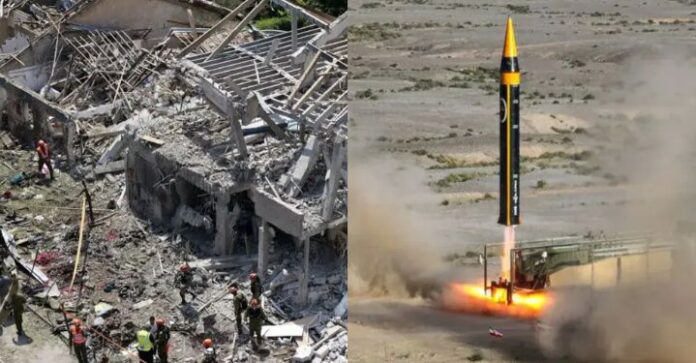Jerusalem/Tehran — In a stunning escalation of Middle East tensions, Iran launched a barrage of long-range ballistic missiles at Israel early Sunday morning, just hours after U.S. forces bombed several Iranian nuclear facilities. The Iranian retaliation included deployment of its most powerful weapon to date, the Kheybar Shekan missile—a move that has left global leaders urgently calling for de-escalation.
The Trigger: U.S. Strikes on Iran
On June 21, the U.S. carried out coordinated strikes on Iran’s nuclear infrastructure, including the Fordow and Natanz enrichment sites, as well as suspected underground military complexes near Isfahan. Washington described the strikes as “surgical and defensive,” aimed at delaying Iran’s progress toward a potential nuclear weapon. Tehran, however, saw the strikes as a direct act of war.
Within 18 hours, Iran responded.
The Retaliation: Missiles Over Israel
Iran fired over 30 missiles toward Israel from within its borders, including multiple Kheybar Shekan missiles—long-range, solid-fueled projectiles capable of traveling over 1,400 kilometers (870 miles). These missiles, known for their maneuverability and precision, marked a significant milestone in Iran’s arsenal deployment.
Multiple cities in Israel—Tel Aviv, Haifa, Ashkelon, and Beersheba—saw air-raid sirens wail as explosions echoed across the skyline. According to the Israel Defense Forces (IDF), most of the missiles were intercepted, but several made impact in urban areas.
Civilian Toll and Response
Israeli emergency services reported at least 80 injuries, including children, though there were no immediate fatalities, which officials attribute to the effectiveness of Israel’s multi-tiered missile defense systems. A direct hit on an apartment block in Haifa caused significant structural damage and led to the evacuation of more than 200 residents.
Hospitals in central Israel went on high alert. “The psychological impact is enormous,” said a spokesperson for Ichilov Hospital in Tel Aviv. “Children and the elderly are particularly affected.”
Iron Dome, David’s Sling, Arrow Activated
Israel deployed its layered missile defense architecture to full effect. The Iron Dome intercepted short-range projectiles, while David’s Sling and the Arrow system targeted longer-range ballistic missiles, including the Kheybar Shekan.
“Out of 30-plus missiles, more than 90% were neutralized before reaching populated areas,” the IDF said. However, one Arrow missile reportedly failed mid-air, sparking concerns over potential saturation tactics by Iran.
Iran’s Messaging: Strategic and Symbolic
Iranian state broadcaster IRINN called the missile strike “a measured yet powerful response” to U.S. aggression and “Zionist crimes.” The use of the Kheybar Shekan, named after a historical Islamic battle, sent a clear message that Iran has advanced weapons capable of reaching deep into enemy territory.
Supreme Leader Ayatollah Ali Khamenei said in a statement, “Iran’s hands are not tied. We will respond whenever our sovereignty is threatened, whether by America or its agents in the region.”
Washington’s Reaction
President Biden held an emergency briefing with the National Security Council, vowing to stand by Israel and stating, “Iran’s attack on our ally will not go unanswered.” The Pentagon began moving additional assets, including F-22 jets and naval strike groups, to the region. Secretary of Defense Lloyd Austin labeled the Iranian strike as “reckless provocation.”
Meanwhile, U.S. embassies in Baghdad, Amman, and Beirut were placed on lockdown amid fears of regional blowback from Iran’s proxy forces.
Global Shockwaves
- UN Secretary-General António Guterres condemned both the U.S. strikes and Iran’s response, urging “maximum restraint” on all sides.
- Russia and China criticized the U.S. for escalating tensions and called for diplomatic dialogue.
- European leaders expressed alarm, with Germany and France initiating emergency consultations through the EU Security Council.
Oil prices spiked to $115 per barrel, and global stock markets opened down amid fears of an impending regional war.
Strategic Military Analysis
The use of the Kheybar Shekan missile has analysts reevaluating Iran’s regional power projection. Dr. Amir Sadeghi, a missile systems analyst in Beirut, said: “This was not just symbolic. Iran has now demonstrated credible strike capability against key Israeli cities from within its borders—something not seen since the 1991 Gulf War.”
Still, Iran’s missile bases are vulnerable to preemptive Israeli and U.S. airstrikes, and military observers note that Iran’s retaliation was “strong but limited,” likely intended to send a message without triggering a full-scale war.
Escalation or Pause?
Despite the severity of the strike, Iran has not yet activated its proxy militias in Lebanon, Iraq, or Yemen. Hezbollah and the Houthis have remained silent, though some sources suggest Iran has given them “green light contingencies” if Israel expands its response.
Israel has not launched a full retaliatory strike on Iran yet but continues to bomb IRGC targets in Syria and western Iraq. Prime Minister Benjamin Netanyahu declared: “We will choose the time and place of our response. We are prepared for any eventuality.”
Diplomatic Channels Reopen—Barely
A late-night phone call between Qatar and Turkey hinted at possible mediation. Both nations are expected to host indirect talks between Iranian and American representatives. The Swiss embassy in Tehran, which represents U.S. interests, also confirmed it had received “urgent correspondence” from Washington.
Conclusion:
The world watches with bated breath as two adversaries, armed with advanced technology and deep-rooted hostility, teeter on the brink of wider war. While Iran’s missile strike may have been designed as a one-off response, it opens the door to a new phase of warfare in the Middle East—one that could reshape the regional balance for years to come.

